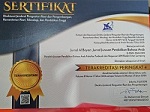The Implementation of Mimicry Memorization Method for Novice Students in Learning Arabic Mufradat
Abstract
Keywords
Full Text:
PDFReferences
Abdurochman, Abdurochman, ‘Strategi Pembelajaran Kosakata Bahasa Arab Bagi Non Arab’, An Nabighoh: Jurnal Pendidikan Dan Pembelajaran Bahasa Arab, 19.1 (2017), 63–83
Ahmad Muhtadi Anshor, Pengajaran Bahasa Arab Media Dan Metode-Metodenya (Yogyakarta: Sukses Offset, 2009)
Akhlihatul ‘Ain, ‘Penerapan Metode Mimicry Memorization Dalam Pembelajaran Mufradat Di MTs Asy-Syafi’iyyah Jatibarang Kabupaten Brebes’ (IAIN Purwakerto, 2016)
Arif Humaini, ‘Experimental Research: The Effectiveness of Card Game Learning Media in Learning Shorof’, Jurnal Al Bayan: Jurnal Jurusan Pendidikan Bahasa Arab, 10.2 (2018), 295–307
Arndt, Henriette L, and Robert Woore, ‘Vocabulary Learning from Watching YouTube Videos and Reading Blog Posts’, Language Learning & Technology, 22.3 (2018), 124–42
Barr, Christopher D, Paola Uccelli, and Emily Phillips Galloway, ‘Specifying the Academic Language Skills That Support Text Understanding in The Middle Grades: The Design and Validation of the Core Academic Language Skills Construct and Instrument’, Language Learning, 69.4 (2019), 978–1021
Bidenko, Larysa, and Ganna Bespalova, ‘Implementing Audio-Lingual Method to Teaching Ukrainian as a Foreign Language at the Initial Stage’, Advanced Education, 7, 2017, 23–27
Bisri Mustafa, and Abdul Hamid, Metode Dan Strategi Pembelajaran Bahasa Arab (Malang: UIN-Malang Press, 2012)
Caplan, Nigel A, ‘Learning through Language: A Response to Polio,“Keeping the Language in Second Language Classes”’, Journal of Second Language Writing, 46 (2019), 100677
Chang, Anna CS, ‘Effects of Narrow Reading and Listening on L2 Vocabulary Learning: Multiple Dimensions’, Studies in Second Language Acquisition, 41.4 (2019), 769–94
Durgunoğlu, Aydin Yücesan, and Martha Bigelow, ‘Classroom-Based L2 Vocabulary Learning and Comprehension: Replications of Lesaux, Kieffer, Faller & Kelley (2010)’, Language Teaching, 50.3 (2017), 384–94
Ekawati, Anita Dewi, ‘The Effect of TPR and Audio-Lingual Method in Teaching Vocabulary Viewed from Students’ IQ’, Journal of ELT Research: The Academic Journal of Studies in English Language Teaching and Learning, 2017, 55–65
Fauzi, Moh Fery, and Irma Anindiati, ‘Tathwir Al-Lughaz al-Raqmy Li Madah al-Tathbiq Al-Sharfy 1 ‘ala al-Hatif al-Mahmul Ka al-Tadribat al-Idhafiyyah Kharij al-Fashl al-Dirasy’, Buletin Al-Turas, 25.1 (2019), 129–39
Fauzi, Moh Fery, Miftahul Fadliah Buhun, and Agus Purwadi, ‘The Influence of Teams Games Tournament (TGT) toward Students’ Interest in Arabic Language Learning’, Izdihar: Journal of Arabic Language Teaching, Linguistics, and Literature, 2.2 (2019), 135–48
Feng, Yanxue, and Stuart Webb, ‘Learning Vocabulary Through Reading, Listening, and Viewing: Which Mode of Input Is Most Effective?’, Studies in Second Language Acquisition, 2019, 1–25
Fischer, Lane, John Hilton, T Jared Robinson, and David A Wiley, ‘A Multi-Institutional Study of the Impact of Open Textbook Adoption on the Learning Outcomes of Post-Secondary Students’, Journal of Computing in Higher Education, 27.3 (2015), 159–72
Ghofur, Abd, I Nyoman S Degeng, Utami Widiati, and Punaji Setyosari, ‘The Effect Of Communicative Language Teaching And Audio-Lingual Method On English Speaking Skill Across Different Learning Styles’, KnE Social Sciences, 2017, 1–7
Herawati, Netty, ‘Audio-Lingual Method as Method in Improving Speaking Ability of Second Semester of English Department Students of UNRIKA’, JURNAL DIMENSI, 1.3 (2016)
Himatul Istiqomah, and Hanik Mahliatussikah, ‘Musykilat Al-Tarbiyyah Tuwajihuha al-Thalabah Fi Ta’allum al-Lughah al-Arabiyah Li Ghairi al-Nathiqin Biha’, Jurnal Al Bayan: Jurnal Jurusan Pendidikan Bahasa Arab, 11.2 (2019), 254–80
Ismail Sholeh, ‘Penerapan Metode Mimicry Memorization Dalam Pembelajaran Al-Kalam Bagi Siswa Kelas XI Madrasah Aliyah Darul Qur’an Gunung Kidul Tahun Ajaran 2014/2015’ (UIN Sunan Kalijaga, 2014)
Karousou, Alexandra, and Theodora Nerantzaki, ‘Phonological Memory Training and Its Effect on Second Language Vocabulary Development’, 36.1 (2020), 1–24
Matamoros-González, Jessenia A, María Asunción Rojas, Johanna Pizarro Romero, Sara Vera-Quiñonez, and Sandy T Soto, ‘English Language Teaching Approaches: A Comparison of the Grammar-Translation, Audiolingual, Communicative, and Natural Approaches’, Theory and Practice in Language Studies, 7.11 (2017), 965–73
Michel, Marije, Judit Kormos, Tineke Brunfaut, and Michael Ratajczak, ‘The Role of Working Memory in Young Second Language Learners’ Written Performances’, Journal of Second Language Writing, 45 (2019), 31–45
Moh. Fery Fauzi, ‘Mawad Al-Mufradat al-’Arabiyyah Fi al-Manahij al-Dirasiyyah ’ala Asasy al-Kafa’ah Bi Indunisia: Dirasah Tahliliyyah Taqwimiyyah ’an Tathbiq Mawad al-Mufradat Fi al-Muqarrarat al-Madrasiyyah’ (UIN Maulana Malik Ibrahim Malang, 2016)
Mubaligh, Ahmad, ‘Relasi Bahasa Dan Ideologi’, Lingua: Jurnal Ilmu Bahasa Dan Sastra, 5.2 (2011), 112–18
Nakata, Tatsuya, and Stuart Webb, ‘Does Studying Vocabulary in Smaller Sets Iincrease Learning?: The Effects of Part and Whole Learning on Second Language Vocabulary Acquisition’, Studies in Second Language Acquisition, 38.3 (2016), 523–52
Patricia A. Herman, and Janice Dole, ‘Theory and Practice in Vocabulary Learning and Instruction’, The Elementary School Journal, 89.1, 43–54
Pavia, Niousha, Stuart Webb, and Farahnaz Faez, ‘Incidental Vocabulary Learning through Listening to Songs’, Studies in Second Language Acquisition, 41.4 (2019), 745–68
Pellicer-Sánchez, Ana, ‘Incidental L2 Vocabulary Acquisition from and While Reading: An Eye-Tracking Study’, Studies in Second Language Acquisition, 38.1 (2016), 97–130
Puimège, Eva, and Elke Peters, ‘Learners’ English Vocabulary Knowledge Prior to Formal Instruction: The Role of Learner‐Related and Word‐Related Variables’, Language Learning, 69.4 (2019), 943–77
Rice, Caitlin A, and Natasha Tokowicz, ‘A Review of Laboratory Studies of Adult Second Language Vocabulary Training’, Studies in Second Language Acquisition, 2019, 1–32
Rifka Zahera, ‘Meningkatkan Motivasi Belajar Siswa Melalui Metode Mim Mem Mata Pelajaran Tahfizul Qur’an Materi Surat-Surat Pendek Kelas III Sekolah Dasar Negeri 006 Limau Manis Kecamatan Kampar Kabupaten Kampar’ (UIN Sultan Syarif Kasim Riau, 2012)
Sari, Risna Rianti, ‘The Use of Keyword and Imagery Mnemonic for Vocabularies Learning for AFL Students’, Izdihar: Journal of Arabic Language Teaching, Linguistics, and Literature, 1.2 (2018), 129–36
Schmitt, Norbert, ‘Understanding Vocabulary Acquisition, Instruction, and Assessment: A Research Agenda’, Language Teaching, 52.2 (2019), 261–74
Schmitt, Norbert, Tom Cobb, Marlise Horst, and Diane Schmitt, ‘How Much Vocabulary Is Needed to Use English? Replication of van Zeeland & Schmitt (2012), Nation (2006) and Cobb (2007)’, Language Teaching, 50.2 (2017), 212–26
Schmitt, Norbert, Paul Nation, and Benjamin Kremmel, ‘Moving the Field of Vocabulary Assessment Forward: The Need for More Rigorous Test Development and Validation’, Language Teaching, 2019, 1–12
Sholihah Sholihah, ‘Penggunaan Media Gambar Dalam Pembelajaran Mufrodat’, Tarling: Journal of Language Education, 1.1 (2017), 62–76
Sugiono Sugiono, Metode Penelitian Pendidikan (Pendekatan Kuantitatif, Kualitatif, Dan R&D) (Bandung: Alfabeta, 2015)
Ulin Nuha, Metodologi Super Efektif Pembelajaran Bahasa Arab (Yogyakarta: Diva Press, 2016)
Webb, Stuart, ‘Learning Vocabulary through Meaning-Focused Input: Replication of Elley (1989) and Liu & Nation (1985)’, Language Teaching, 49.1 (2016), 129–40
DOI: http://dx.doi.org/10.24042/albayan.v12i2.5953
Refbacks
- There are currently no refbacks.
Copyright (c) 2020 Jurnal Al Bayan: Jurnal Jurusan Pendidikan Bahasa Arab
License URL: https://creativecommons.org/licenses/by-sa/4.0
Editorial Office:
Jurnal Al Bayan: Jurnal Jurusan Pendidikan Bahasa Arab, Arabic Education Study Program, Faculty of Education and Teachers Training, Unversitas Islam Negeri Raden Intan Lampung
Jl. Endro Suratmin 1 Sukarame, Bandar Lampung 35131-Indonesia
e-mail: jurnalalbayan@radenintan.ac.id
http://ejournal.radenintan.ac.id/index.php/albayan/index
Jurnal Al Bayan: Jurnal Jurusan Pendidikan Bahasa Arab is licensed under a Creative Commons Attribution-ShareAlike 4.0 International License. p-ISSN 2086-9282 | e-ISSN 2549-1229









